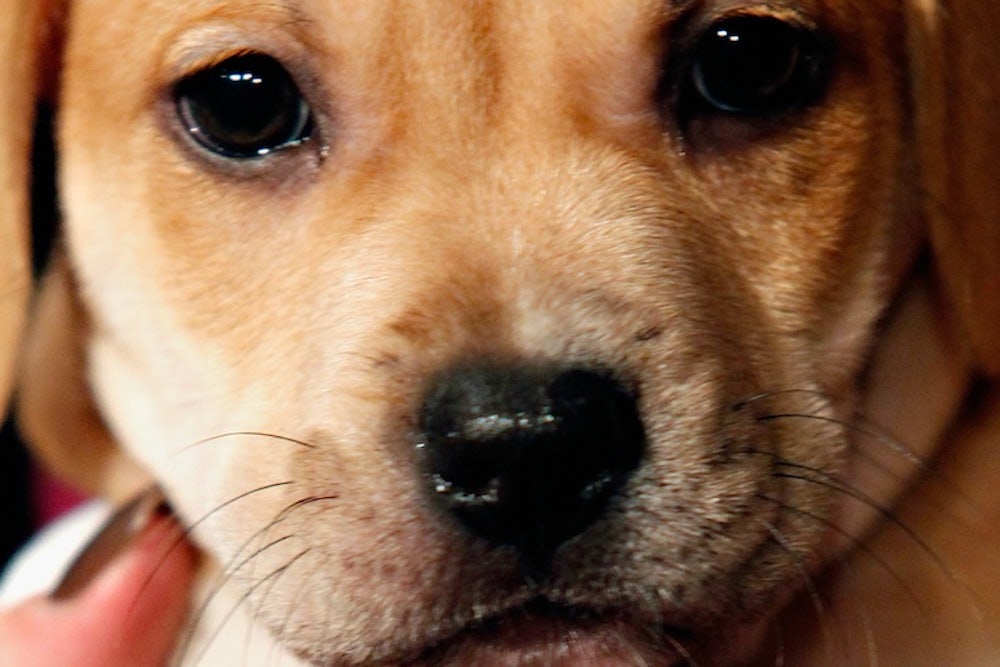Every year, the Super Bowl broadcast attracts over 100 million fans from around the country, picking up viewers across the race, gender, income and age lines that usually divide American audiences. The show that's on after it, though, has the potential to appeal to all humanity.
After the Denver Broncos and Seattle Seahawks face off in New Jersey’s MetLife Stadium on February 2, 66 puppies will compete in Animal Planet’s tenth annual Puppy Bowl. While football capitalizes on people’s geographic allegiances and interest in players’ and coaches’ personal stories, the puppy bowl takes advantage of something more innate: humans’ appreciation of cuteness.
Why do we like to look at cute puppies? It may be the same reason we appreciate—and care for—human babies. Back in 1949, the Austrian ethologist Konrad Lorenz hypothesized that babies’ cuteness constitutes an evolutionary trigger that compels adults to feed and nurture them. Cuteness, according to Lorenz, is a crucial biological mechanism, because without constant care from adults, babies would never make it into adulthood. Lorenz located babies’ cuteness in their disproportionately large eyes, small noses, chubby cheeks and miniature hands and feet— a set of features he termed Kindchenschema.
In the 1960s, the anthropologist Jane Goodall extrapolated Lorenz’ cuteness theory to chimpanzees. Goodall found that baby chimps she worked with in Tanzania were safe from adults’ aggression as long as they retained the tuft of white hair on their tails. She suggested that the white tail tuft signals adult chimpanzees to be gentle towards the young—just as Kindchenschema inspire adults to take care of babies.
In another famous paper on cuteness, evolutionary biologist Stephen Gould showed how Mickey Mouse took off as Disney’s cartoonists began giving him cuter, more baby-like features. When he was first drawn in the 1930s, Mickey Mouse resembled a lithe adult man, but over the next fifty years, he aged in reverse: His eyes and head got bigger while his arms and legs got shorter and thicker, until he began to resemble a human infant.
New research provides empirical evidence for Lorenz’s hypothesis. For a paper in the journal PLOS ONE, a team of psychologists led by Jessika Golle at the University of Bern argue based on students’ reactions to babies’ and puppies’ faces that there is a universal mechanism underlying our appreciation of both animals and babies.
First, Golle and her team printed out pictures of babies’ faces and had ten students rank them on a scale of one (“not at all cute”) to seven (“very cute”). She then recruited 24 undergraduate students and showed them a series of pictures of babies that had been rated either cute or not-cute. Once they’d been exposed to many faces, the students were asked to rank other baby pictures. Golle found what she terms “cuteness after-effects”:
After adapting to less cute infant faces, the faces in the post-adaptation phase were assessed cuter (M = 4.03, SE = 0.13) compared to after adapting to cute faces (M = 3.29, SE = 0.13).
Golle then set out to figure out if the “cuteness after-effects” would work for other animals. If her subjects were exposed to cute babies, would they rank puppies as less cute? “If cuteness after-effects indeed transfer across species,” explained Golle, “This would be strong evidence for Lorenz’ (1943) claim that the Kindchenschema is universal.”
Golle set up a similar experiment, but substituted puppies for babies in the exposure round: She showed students pictures of cute or not-cute puppies, then had them rank the cuteness of human babies. And, as Lorenz would have predicted:
After adapting to cute puppy dogs, human infant faces were evaluated to be less cute, while the same human infants were rated to be cuter after adapting to less cute puppies. We note that the after-effect was smaller when adaptor and test faces were of different species. In the first experiment the size of the effect was larger (ηp2 = .63) compared to the effect in the second experiment (ηp2 = .22). This however does not take away from our claim that there is a common coding mechanism for cuteness….Our data suggest a common mechanism that codes the cuteness of human and non-human infant faces.
The only show that could have a broader appeal: a Baby Bowl.
